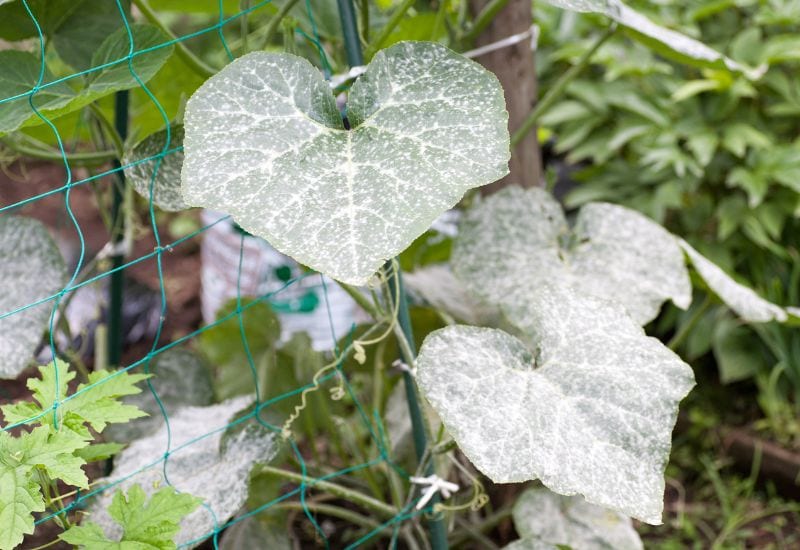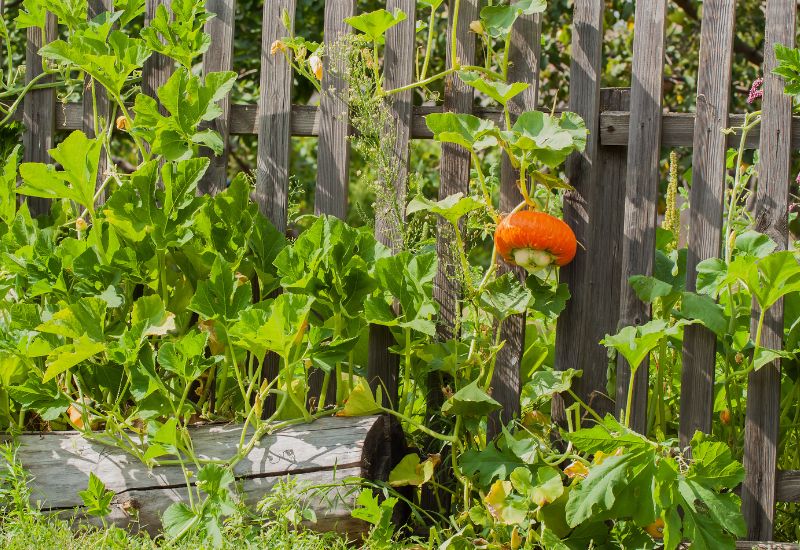We always laugh when the whimsical creatures of Beatrix Potter’s world gorge themselves in Mr. McGregor’s garden, but it is another matter entirely when these bushy tailed creatures invade our pumpkin patch and eat our fall store.
We often think of rabbits eating carrots and lettuce, but they can be just as devastating to our pumpkin plants. They will eat all parts of the pumpkin plant, and while they may have a preference for tender seedlings, they will also devour the mature vines, and even the gourds themselves.
Thankfully, there are a number of ways to keep rabbits from eating your pumpkins. While nothing is as effective as a good fence (a rabbit-proof fence can be built quickly and cheaply), you can also deter them with sound, flashing lights, a blast of water, fake animals, or repel them with sprays or plants.
Killing them certainly isn’t an option in my books, so here are ethical ways to keep rabbits from eating your pumpkins.
Do Rabbits Eat Pumpkin Plants?
Yes, rabbits will happily feast on your pumpkin patch. All parts of a pumpkin plant are edible for these animals and rabbits will eat the leaves, stems, flowers, young gourds, and mature pumpkins including the skin, flesh, and seeds.
They will also eat any variety of pumpkin (or any winter squash for that matter), and will do so throughout the year.
Why Rabbits Eat Pumpkins?

Rabbits eat pumpkins very well, so why do most websites for domestic rabbits suggest only feeding them in small quantities and very infrequently?
The reasoning is that pumpkins are full of sugar and carbohydrates, both of which can make your pet rabbit sick or obese in large quantities.
However, this doesn’t make a lick of sense, since most carrots contain equal amounts of carbs, and even more sugar than the same weight of raw pumpkin. In the wild, rabbits will eat through your pumpkins without a care in the world.
From a wild rabbit’s point of view, your pumpkins are a good source of food:
Signs Of Rabbit Damage On Pumpkin Plants?

Many different types of long-eared lagomorphs will eat your pumpkin patch. There are 29 rabbit species and 30 different hares and each one can cause a problem for your garden depending on where you live.
Of course, there are countless other creatures that will also eat your pumpkins, so it is important to determine that you are in fact dealing with rabbits so you can properly protect your squash.
If you catch them in the act it is clear enough, but most of the time we don’t see rabbits eating our garden as they avoid moving about midday and are most active in the early morning or late evening.
Here are some ways to identify that you are dealing with rabbits:
If you suspect rabbits are in your garden but the signs are inconclusive, ask your neighbours if they have seen rabbits in your area. Or maybe they know of a burrow nearby (remember, not all rabbits dig burrows, but will often sleep in shallow depressions in asheltered area.
11 Ways to Prevent Rabbits From Eating Your Pumpkins

If rabbits run rampant in our area, it is best to put up preventive measures before you even plant your pumpkins. But even if they move into your garden once your plants are growing, here are the most reliable way to keep rabbits from eating your pumpkin plants:
TIP: While each of these methods can be effective on their own, they work much better when combined together to give your pumpkins maximum protection!
1: Erect A Fence Around Your Pumpkin Patch

Only sure fired way to keep out rabbits is with solid fence. Here are simple steps to erecting a rabbit fence around your pumpkins:
2: Cover Your Pumpkin Plants With Netting Or Row Covers

If you only have one or two pumpkin plants, consider putting a net over them rather than building an intensive fence. Of course, netting is not as effective as a net, but it can still be enough of a deterrent to keep rabbits away.
The problem with pumpkins is that the sprawling vines can be difficult to cover, but there are many gardening and agriculture nets that would work quite well.
Floating row covers are an excellent option, but check out your garden centre or contact a local wildlife organization for more options. Whichever net you use, make sure it is “wildlife friendly”.
3: Use Rabbit Repellents That Are Safe For Edible Crops

Rabbits have a strong sense of smell, so they are fairly easy to deter will strong smelling products. In many cases, you can use products you have lying around your home.
Sprinkle or spray these repellants on your pumpkin plants and the surrounding soil. They will have to be reapplied after a heavy rain as they are easily washed away.
Here are some of the most popular rabbit repellents you can use to keep them away from pumpkin plants:
4: Plant Rabbit-Resistant Flowers And Herbs Near Your Pumpkins

Why not try and repel rabbits by growing other plants? Some strong scented plants will repel or confuse rabbits with their aroma, and some plants will keep rabbits away because they don’t like eating them. Unfortunately, no plant is truly rabbit-proof and they will try eating even toxic plants as a test.
While this is certainly not the most guaranteed method of keeping rabbits away from your pumpkins, growing some of the following plants that rabbits don’t like will help keep them away.
5: Use Live Traps To Catch And Relocate Rabbits Away From Your Garden

There are a number of humane traps that you can use to catch and release the rabbits somewhere else. There are many regulations around trapping and releasing wild animals, so check with the local authorities as to what you can, and cannot do, and where you can release them.
When relocating animals, it is very important to take into account the time of year. For example, relocating an adult rabbit when there are kits needing to be fed is an unethical way to reduce the rabbit population. Also, relocating a rabbit to a new area too late in the year could sentence them to a slow death from exposure and starvation.
6: Hang Strips Of Reflective Tape Or Aluminum Foil Near Your Pumpkins
There is an age-old legend that says rabbits are afraid of their own shadow and reflection. Whether they are or not, putting mirrors, reflective surfaces, or glass jars filled with water around your garden can confuse and frighten the rabbits and keep them out of your garden.
These can be incorporated in a very decorative way to improve the aesthetics of the garden while protecting your pumpkins at the same time.
You can also try lights or strobes controlled by a motion sensor to give them an extra visual scare.
7: Set Up Motion-Activated Sprinklers

Hook a motion sensor sprinkler up to your garden hose, position it near your pumpkin patch, and when a rabbit comes close it will get a sudden blast of water. These are very safe, effective, and humane and will also work against dogs, cats, raccoons, and other garden raiders.
Make sure to move the sprinkler to a new spot every now and then, otherwise the wily rabbits might get used to them or find a blind spot in the sensor.
8: Propane Boom Cannons
You should only use these if you live in the country or your neighbors will probably complain. Propane boom cannons are hooked up to a standard propane tank.
The cannon slowly fills a chamber with gas, and then suddenly lets out a loud boom sound that scares all animals nearby (and your family if you are not expecting it).
They are not a good idea with a small garden close to your house, but they would be very effective in a larger market garden.
9: Play A Radio Or Music In Your Garden On A Low Volume
A more pleasing way to keep rabbits away with sound is to turn on a radio in your garden. Put a stereo in a sheltered place to protect it from the elements and turn it on so the rabbit thinks that people are around.
Talk shows usually work best since this sounds most like people are in the garden, but loud or startling music is also effective.
Of course, your neighbours might still be annoyed by music and talk shows playing all hours of the day, so talk to them first, or consider putting the stereo on a timer so it won’t run all night and only turns on at peak rabbit hours (early morning and late evening).
Make sure to change the channel every few days and move the stereo to different positions every so often to confuse the rabbits.
10: Eliminate Hiding Places
Another way to keep out rabbits is by creating an unfriendly rabbit environment.
I like creating an aesthetically pleasing garden, that is full of plants, trees, shrubs, and ornamental features. Unfortunately, these are places where rabbits can hide as they sneak in to eat the pumpkins.
Most rabbits don’t like to leave cover if they don’t have to, so remove anything that can conceal them by removing brush, raking leaves, covering holes under sheds, or filling in old burrows.
11: Install Realistic-Looking Predator Dummies In Your Garden
Rabbits are pretty much at the bottom of the food chain which means they are scared of pretty much everything. Putting pretend predators around your garden makes your garden look like it is being guarded by fearsome creatures and this can keep the rabbits away.
There are a number of predator dummies you can use such as owls, hawks, cats, dogs, or even rubber snakes.
In order for predator dummies to be even remotely successful, they have to be moved every couple of days otherwise the keen-eyes prey will realize they are just a statue.
11: Start Pumpkin Seedlings Indoors

It is often suggested to start your seedlings indoors rather than directly in the garden. In my experience, this isn’t a very practical option. Pumpkins do not generally transplant very easily, and you will still have to worry about rabbits eating your transplants once you set them out.
If you do want to protect your pumpkins during the delicate (and delectable) seedling stage, start your seeds indoors and transplant the pumpkins outside 6 to 8 weeks later, or when the plants have 3 to 5 sets of true leaves.
Pumpkin Pillagers, No More!
I love pumpkins. Not only are they one of my favorite squash to eat and bake with, but there is nothing more enchanting in the garden than a pumpkin patch.
The short and cool season in my Zone 2 garden poses a challenging, but not insurmountable, problem and I certainly don’t want to see any of the pumpkins that I do manage to grow being eaten by rabbits (or anything else for that matter).
Not only do rabbits threaten the scrumptiousness of Thanksgiving dinner, but they belittle our year-long struggles that brought the vines to fruition.
I hope you will have some ideas on how to ethically stop rabbits from eating your pumpkins so you can still enjoy a delicious, and hard-earned, pie.










